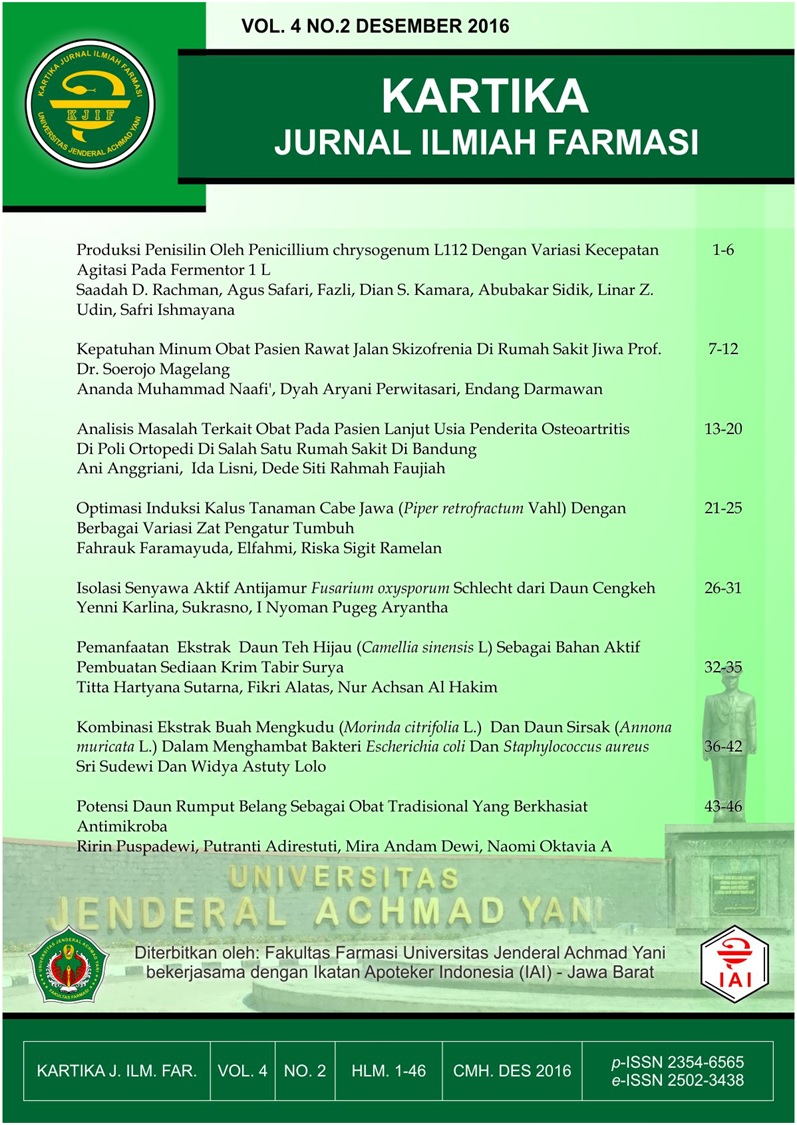KEPATUHAN MINUM OBAT PASIEN RAWAT JALAN SKIZOFRENIA DI RUMAH SAKIT JIWA PROF. DR. SOEROJO MAGELANG
DOI:
https://doi.org/10.26874/kjif.v4i2.60Abstrak
ABSTRAK
Â
Skizofrenia adalah gangguan mental yang menyebabkan seseorang menjadi disfungsional secara fisiologis untuk dirinya sendiri maupun interaksi secara sosial. Kepatuhan minum obat dapat dideteksi melalui pengisian beberapa jenis kuisioner kepatuhan minum obat antara lain Medication Adherence Rating Scale (MARS). Tujuan penelitian ini adalah untuk mengetahui gambaran tingkat kepatuhan pasien rawat jalan skizofrenia dan untuk mengetahui hubungan antara karakteristik pasien dengan tingkat kepatuhan minum obat pasien rawat jalan skizofrenia di Rumah Sakit Jiwa Prof. Dr. Soerojo Magelang. Rancangan penelitian ini menggunakan metode observasional yang memakai desain penelitian Cross Sectional. Analisa data dilakukan dengan uji Cross tabulation. Hasil penelitian menunjukkan 40 pasien rawat jalan skizofrenia yang memenuhi kriteria inklusi terdiri dari 60% laki-laki dan 40% perempuan. Pasien dengan tingkat kepatuhan rendah sebanyak 2,5%, 90% pasien memiliki tingkat kepatuhan sedang, dan 7,5% pasien memiliki tingkat kepatuhan tinggi. Untuk melihat hubungan karakteristik pasien (usia, jenis kelamin, pendidikan, pekerjaan) dengan tingkat kepatuhan minum obat pasien digunakan analisis bivariat dengan uji Cross tabulation dan diperoleh nilai signifikansi berturut-turut 0,723; 0,066; 0,595; dan 0,078 (p>0,05). Dari hasil tersebut dapat disimpulkan bahwa tidak ada hubungan antara karakteristik pasien dengan tingkat kepatuhan pasien rawat jalan skizofrenia tersebut.
Â
Kata kunci:Â Skizofrenia, kepatuhan pasien, MARS, rawat jalan
Â
ABSTRACT
Â
Schizophrenia is a mental disorder that makes someone physiologically dysfunctional both on interaction with himself and with people around him. The medication adherence can be measured by some questioners, one of them is Medication Adherence Rating Scale (MARS). The study is aimed to know the picture of the medication adherence level of the Schizophrenia outpatients and the relationship between the patients’ characteristic and the medication adherence at Prof. Dr. Soerojo Mental Hospital Magelang. The research design applied on the study is observational method which is applied Cross Sectional research design. The analysis was carried out with Cross tabulation test. The result shows that from 40 Schizophrenia outpatients who achieved inclusion criteria is consist of 60% man and 40% woman. The patients with low level medication adherence are 2.5%, medium level are 90%, and high level are 7.5%. The test to analyze the relationship between the patients characteristic (age, gender, education, occupation) with the medication adherence level is bivariat analysis with Cross tabulation test. The result shows significance value consecutively 0.723; 0.066; 0.595; and 0.078 (p>0.05). It can be concluded from the result that there is no relationship between the patients characteristic and the patients medication adherence level.
Â
Keywords:Â Schizophrenia, patients adherence, MARS, outpatients
Referensi
Aleman, A., Khan, R., Paul, S.J., 2003, Sex differences in the risk of schizophrenia, Archive General Psychiatry, 60: 565-571, 195.
Amelia, D.R., & Anwar, Z., 2013, Relaps pada Pasien Skizofrenia. Jurnal Ilmiah Psikologi Terapan, 7(1): 105-112.
Claramita, M., 2012, Doctor–Patient Communication in Southeast Asia: A Different Culture, 565-571, Springer, Netherlands.
Eisenstat, A.S., Nathan, D.M., Ellen, B., 2007, Every Man’s Guide to Schizophrenia, 2, Harvard University Press, London.
Fenton, W.S., Blyler, C.R., & Heinssen, R.K., 1997, Determinants of Medication Compliance in Schizophrenia: Emirical and Clinical Findings, Schizophrenia Bulletin, 5(3): 637-650.
Hawari, D., 2006, Pendekatan Holistik pada Gangguan Jiwa Skizofrenia, Edisi 3, Balai Penerbit FKUI, Jakarta.
Kirkbride, F., 2006, Gender differences in patients with schizophrenia in terms of sociodemographic and clinical characteristics, German Journal of Psychiatry, 9: 41-47
Lawrence D., Hancock K.J., Kisely S., National Institute of Mental Health, 2002, An Overview of Schizophrenia, diakses pada tanggal 16 April 2013 dari http://www.nimh.nih.gov/.
Leucht, S., Corves, C., Arbter, D., Engel, R.R, Li, C., Davis, J.M., 2009, Second-generation versus first-generation antipsychotic drugs for schizophrenia: A Meta-Analysis, Lancet, 11(2): 31-41.
McGrath, J.J., 2006, Variations in the incidence of schizophrenia: data versus dogma, Schizophrenia Bulletin, 32: 195-197, 196.
Morisky, D.E., Ang, A., Marie, K., Harry, J.W., 2008, Predictive Validity of a Medication Adherence Measure in an Outpatient Setting. The Journal of Clinical Schizophrenia, 10(3): 348-354.
Osterberg, L., Blaschke, T., 2005, Adherence to Medication, The New England Journal of Medicine, 6(2): 487-495.
Pantelis, C., & Lambert, T.J., 2003, Managing patients with treatment resistant Schizophrenia. Medical Journal of Australia, 2(3): 62-66.
Roberta, T., 2002, Hidup Optimal dengan Skizofrenia, 45-52, PT. Bhuana Ilmu Populer, Jakarta.
Sadock, B.J., & Sadock, V.A., 2007, Kaplan & Sadock’s Synopsis of Psychiatry: Behavioral Sciences / Clinical Psychiatry (10th edition), 54-60, Philadelphia: Lippincott Williams & Wilkins.
Sadock, B.S., & Sadock, V.A., 2010, Kaplan and Sadock’s Pocket Handbook of Clinical Psychiatry, 101-113, Philadelphia: Lippincott Williams & Wilkins.
Saha, C., Eichenberger, A., Luginbuhl, P., Keller, C., 2003, Determinants of burden in caregivers of patients with exacerbating schizophrenia. Psychiatric University Hospital. 18: 285.
Seeman, J., Chen, C.Y., Eaton, W., 2007, Epidemiology of schizophrenia: review of findings and myths, Psychiatry, 30: 69-75.
Sustrani, L., Alam S., Hadibroto, I., 2006, Skizofrenia, 19-20, PT. Gramedia Pustaka Utama, Jakarta.
Sweileh, W.M., Ihbesheh, M.S., Jarar, I.S., Sawalha, A.F., Abu Taha, A.S., Zyoud, S.H., Morisky, D.E., 2012, Antipsychotic Medication Adherence And Satisfaction Among Palestinian People With Schizophrenia. World Journal of Schizophrenia, 8(5): 49-64.
Yasamy, M.T., Cross A., McDaniell E., Saxena S., 2010, International Classification of Diseases, diakses tanggal 10 Oktober 2014 dari http://apps.who.int/classifications/icd10.
Zygmunt, A., Offson, M., Boyer, C.A., & Mechanic, D., 2002, Interventions to Improve Medication Adherence in Schizophrenia. Am J Psychiatry, 78(5):1653–1664
##submission.downloads##
Diterbitkan
Cara Mengutip
Terbitan
Bagian
Lisensi
Penulis yang menerbitkan artikel pada jurnal ini menyetujui ketentuan berikut:
- Penulis memberikan hak cipta dan jaminan atas artikel sebagai publikasi pertama, yang memberikan kesempatan pada orang lain untuk membagi artikel dibawah lisensi Creative Commons Attribution License
- Penulis dapat melakukan perubahan dan menambahkan untuk pendistribusian artikel yang terpublikasi secara non eksklusif (misalnya, mempostingnya ke repositori institusional atau mempublikasikannya dalam sebuah buku), dengan pengakuan publikasi awal dalam jurnal ini.
- Penulis diizinkan dan didorong untuk memposting pekerjaan mereka secara online (misalnya, di repositori institusional atau di situs web mereka) sebelum dan selama proses pengajuan, karena dapat mengarah pada pertukaran produktif, serta kutipan pekerjaan sebelumnya dan lebih besar yang diterbitkan (Lihat The Effect of Open Access).























